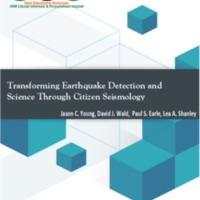Transforming Earthquake Detection and Science Through Citizen Seismology
Dublin Core
Description
Both the public and emergency response teams must quickly mobilize mafter an earthquake in order to save lives and money. Traditionally, many national agencies have relied on a system of sophisticated sensors to detect an earthquake and to determine the attributes of the earthquake that have implications for disaster follow-up, such as the type of earthquake and its magnitude, depth, and epicenter (i.e., location on the earth’s surface). In the United States, for example, the National Earthquake Hazards Reduction Program (NEHRP) was established to reduce the risks associated with future earth quakes. To accomplish this mission, the NEHRP operates and maintains the USGS Advanced National Seismic System (ANSS), a nationwide network of more than 7,000 sensors that provide real-time earthquake information. This network includes nearly 100 backbone stations and regional seismic networks, in addition to the National Earthquake Information Center (NEIC) and the National Strong Motion Project.
Source
https://www.wilsoncenter.org/sites/default/files/CitizenSeismology_FINAL.pdf
Publisher
Contributor
Rahmah Agustira
Rights
Creative Commons
Type
Files
Citation
Jason C. Young et al., “Transforming Earthquake Detection and Science Through Citizen Seismology,” Open Educational Resources (OER) , accessed January 16, 2026, http://oer.uinsyahada.ac.id/items/show/185.


